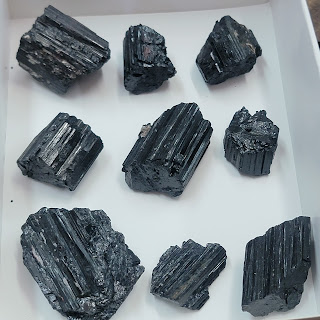Geology of Black Tourmaline
Formation and Composition
Black tourmaline belongs to the tourmaline group, a complex family of borosilicate minerals that can contain a variety of elements, including iron, magnesium, and aluminum. Schorl, the black variety, owes its dark coloration to high iron content.
This mineral typically forms in granite pegmatites, metamorphic rocks like schist, and hydrothermal veins. Tourmaline crystals grow in elongated, striated prisms that can range from small grains to large, well-formed crystals. The hexagonal crystal structure and natural pleochroism (color variation depending on light angle) of varieties other than schorl make tourmaline a fascinating mineral for both scientific study and collecting.
Occurrence and Mining Locations
Black tourmaline is found in various regions worldwide, including:
Brazil – One of the most prolific sources of high-quality tourmaline, particularly in Minas Gerais.
Afghanistan and Pakistan – Known for producing both black and colorful varieties of tourmaline.
Madagascar – A key location for schorl deposits.
United States – California and Maine have notable deposits, with black tourmaline occurring alongside other pegmatite minerals.
Africa – Namibia and Mozambique are also known for their tourmaline-rich geological formations.
Historical Significance of Black Tourmaline
Ancient Uses
The use of tourmaline, including black tourmaline, dates back thousands of years. The name “schorl” originates from a German mining village where black tourmaline was first recorded in the 16th century. However, the mineral itself had been utilized long before that.
Ancient Egypt – Egyptians believed tourmaline traveled along a rainbow during its formation, which led to the wide variety of tourmaline colors. Though black tourmaline was less favored aesthetically, it was still used in amulets and jewelry.
Chinese and Indian Traditions – Tourmaline was highly valued in traditional Chinese and Indian cultures for its believed energetic properties and was often used in carvings, talismans, and medicinal applications.
European Renaissance – In the 18th century, Dutch traders brought tourmaline to Europe from Sri Lanka, where it was used as a decorative stone and studied for its unique electrical properties.
Scientific Discovery and Piezoelectric Properties
One of the most intriguing aspects of tourmaline is its piezoelectric and pyroelectric properties.
Piezoelectricity – When subjected to mechanical stress, tourmaline generates an electrical charge, making it useful in pressure sensors and electronic devices.
Pyroelectricity – When heated, tourmaline produces an electrical charge, which fascinated scientists in the 18th and 19th centuries. It was used in early scientific experiments to study electromagnetism.
Modern Uses
Beyond its geological and historical significance, black tourmaline continues to be used in various applications today:
Jewelry and Decorative Objects – Despite being less transparent than other tourmaline varieties, schorl is still used in fine jewelry and carvings.
Industrial Applications – Due to its electrical properties, tourmaline is used in pressure gauges, electronic components, and even hair styling tools.
Collectors and Museums – Large and well-formed black tourmaline crystals are sought after by collectors and are displayed in museums worldwide.
Conclusion
Black tourmaline is more than just a striking black crystal—it has a remarkable geological formation process, a global presence in mineral deposits, and a long history of use in cultures around the world. Whether studied for its scientific properties, admired for its natural beauty, or collected for its historical significance, black tourmaline remains one of the most intriguing minerals on Earth.






No comments:
Post a Comment